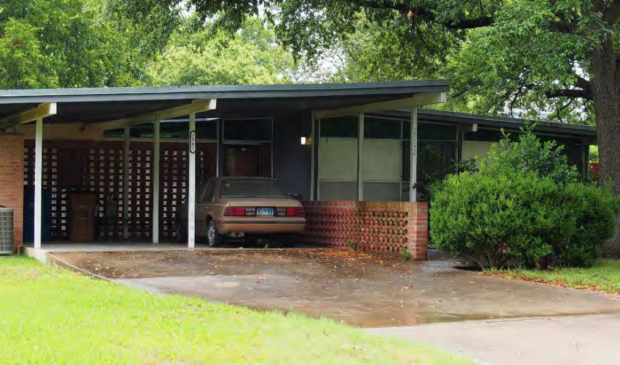No historic zoning for experimental air-cooled house
Tuesday, May 24, 2022 by
Jo Clifton With no City Council member willing to make a motion for historic zoning that was sure to fail, the push to preserve the Chrysler Air-Temp house at 2502 Park View Drive died quietly at last Thursday’s Council meeting.
Owner Hugh Corrigan opposed the historic designation that would have prevented him from demolishing the structure and building a new home on the site in the Allandale neighborhood.
Neither Council Member Leslie Pool nor Council Member Kathie Tovo, both of whom supported historic zoning, could see enough votes to change its fate, so neither made a motion for the historic designation. Because of the owner’s opposition, it would have taken nine votes to zone the house historic.
The house, which sits in Pool’s District 7, was part of a “a national experiment to determine the feasibility of installing and operating central air-conditioning systems in new middle-class residences,” according to the staff report. The report notes that “the Austin Air-Conditioned Village consisted of a set of test houses built for the purpose of exploring the integration of central air-conditioning into mid-priced residences. Conceived in 1953 by the air-conditioning sub-committee of the National Association of Home Builders, the experiment proposed a season’s worth of testing on a group of occupied houses.” In early 1954, 22 test houses were built near the northwest edge of Austin, “ranging from 1,145 to 1,468 square feet, designed to sell for $12,000 plus the cost of land.”
Joe Reynolds, a member of the Allandale Neighborhood Association zoning committee, told Council that this Air-Temp house was probably the first one to boast the new version of A/C, serving as a model for air-conditioned homes throughout the South.
Several architects, neighbors and supporters of historic preservation told Council members they should not miss the opportunity to preserve the house. They described a house that was in remarkably good shape.
But Corrigan disputed that, and accused those in favor of preservation of using “false narratives” about him as well as the condition of the property. He noted that property owners had rejected an attempt to make their subdivision a National Register historic district, showing that a majority of neighbors supported his position. He told Council, “I object to the attempts to rezone the property against my wishes. … The efforts to create support for this rezoning were pushed by the residents who campaigned for national preservation.”
According to the staff report that incorporated comments from historians and architects, “The Chrysler Air-Temp house is an excellent and remarkably intact example of an architect-designed midcentury modern house. Notable features include the use of modern materials, deep eaves and the bold statement of the columns and beams of the house and its attached double carport. The house reflects the basic tenets of midcentury-modern design and satisfies the criterion for architecture.”
The Historic Landmark Commission voted unanimously to recommend historic zoning for the house, but the Zoning and Platting Commission sent the matter forward to Council without a recommendation.
Carolyn Croom described the importance of the home in Austin’s history, saying, “This home deserves a place among Austin’s historic mansions and public buildings. The opportunity to save a house such as this appears quite rarely, and our city should not miss that opportunity.”
“I don’t think it would be useful for anyone to prolong this case if it’s clear that it won’t be successful,” Pool said. “The owner of this house is opposed to historic designation, but there are many Chrysler Air-Temp village houses. What I would like to see and what I think would be successful would be for owners of other Chrysler Air-Temp homes to come forward and have historic designation applied to their homes.” She said she would not offer a motion.
Tovo noted that Council has only approved possibly three historic zoning cases over objections from the owner. “It’s a high threshold and I agree with my colleague that if there were to be a motion on this item, I don’t believe it would be successful. I do agree with those who have weighed in that this is a historically significant structure. It meets the criteria in our zoning ordinance. If we have a historic landmark designation ordinance, we ought to use it and follow it. I support those of you who have argued for the rezoning to historic.”
She concluded, “In my experience I think we’ve had more feedback advocating for the historic preservation for this structure than we have for many other structures I have heard testimony about in the time I’ve been on the dais. I think it’s unfortunate. It sounds as if the owner is very set and determined to move forward with the demolition.” She said Preservation Austin had written a letter expressing its willingness to work with the property owner, as it has with others, “to help figure out a path forward to use the structure and to add on to it and accommodate it for modern purposes and to address the other challenges.”
But Tovo made no motion, and as Mayor Steve Adler explained, without a motion the case was dead.
The Austin Monitor’s work is made possible by donations from the community. Though our reporting covers donors from time to time, we are careful to keep business and editorial efforts separate while maintaining transparency. A complete list of donors is available here, and our code of ethics is explained here.
You're a community leader
And we’re honored you look to us for serious, in-depth news. You know a strong community needs local and dedicated watchdog reporting. We’re here for you and that won’t change. Now will you take the powerful next step and support our nonprofit news organization?







